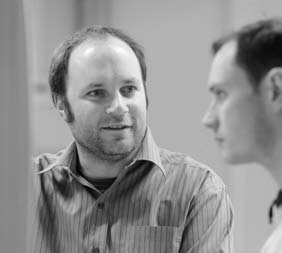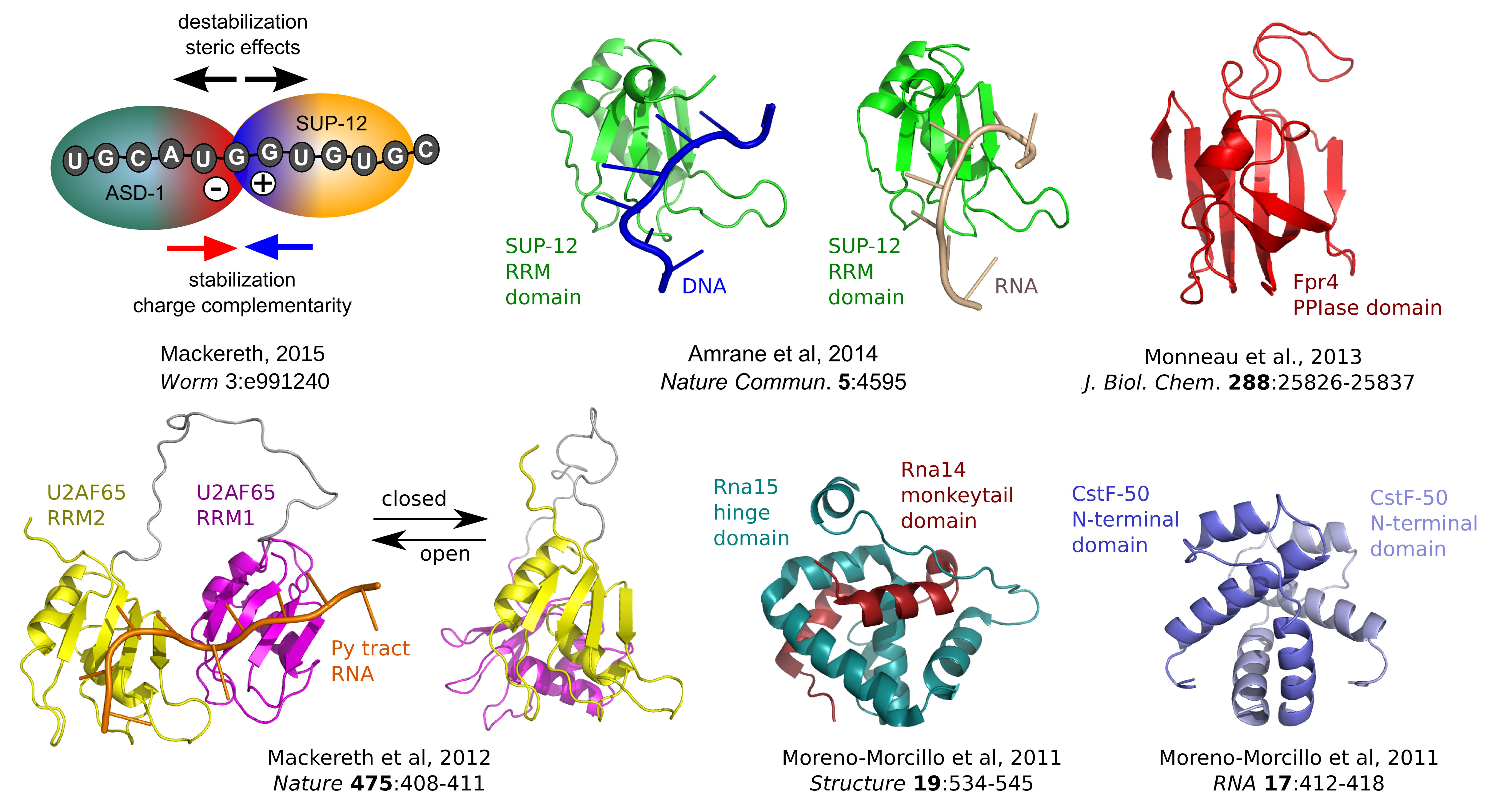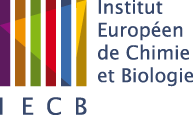 Dr. Cameron Mackereth Dr. Cameron Mackereth
ICSN/CNRS
This e-mail address is being protected from spambots. You need JavaScript enabled to view it
Website
Tel: +33(0)540003432
Bio
Cameron Mackereth began his scientific training at the University of Waterloo (Canada) where he completed a degree in Biochemistry in 1996. His Ph.D. at the University of British Columbia (Canada) under the supervision of Dr. Lawrence McIntosh dealt with the structural investigation of a domain common to several protein families involved in transcription and cellular signaling. He continued to use nuclear magnetic resonance (NMR) spectroscopy at the European Molecular Biology Laboratory (EMBL) in Heidelberg, Germany, where he looked at domain arrangements of large protein-RNA splicing complexes in the group of Dr. Michael Sattler. In the fall of 2007, he joined the IECB as a group leader. In 2011 he was also recruited as a senior research associate within the French National Institute of Health and Medical Research (Inserm).
Keywords / Expertise / Techniques
NMR spectroscopy, protein-RNA complexes, pre-mRNA processing, alternative splicing, protein-protein interactions, domain architecture, epigenetics, histone modification
Summary
The lab studies molecular details of large protein-nucleic acid macromolecules and other complexes using a variety of new NMR techniques as well as established biophysical approaches. For large complexes, we combine small angle neutron or X-ray scattering (SANS/SAXS), NMR paramagnetic spin labeling to acquire information on long-range contacts, as well as in vitro mutational analysis and other binding assays. Equally important to the lab is the traditional strength of NMR as a tool to probe the dynamics of biological samples, the characterization of transient interactions, and the possibility to look at structures that exhibit a significant amount of unstructured elements.
Activity report
Molecular basis of alternative splicing in muscle and neuron development.
A main goal of the group is to determine the atomic basis by which splicing factors have a selectivity for specific mRNA, and to also look at how they regulate splicing patterns of key genes during tissue development. We use this information to design strategic tools for in vivo work, to predict functional interactions with other splicing proteins, and to understand the role of abnormal splicing in disease. Recent studies include the investigation of the alternative splicing factor SUP-12 that functions in a muscle-specific manner to produce an isoform of the fibroblast growth factor receptor (egl-15). In this study, as well as several others currently in progress, we rely on the model organism C. elegans as a powerful tool to correlate in vitro findings with splicing observation in a live multi-cellular organism. This work involves close collaboration with the group of Denis Dupuy, also at the IECB. We have used NMR spectroscopy to determine the atomic structure of the RNA-binding domain from SUP-12 in complex with a high affinity RNA ligand derived from the egl-15 gene. The atomic details were used to design and test precise mutants in the protein and also the target pre-mRNA, and to look at the consequence of these mutations with in vivo fluorescent mini-gene reporters.

Complexes involved in pre-mRNA 3’ processing
In collaboration with the lab of S. Fribourg at IECB, we are investigating the structure and dynamics of the yeast cleavage/polyadenylation factor IA (CF IA) and metazoan cleavage stimulation factor (CstF) complexes, both involved in the removal of the terminal sequence of the pre-mRNA prior to the addition of multiple adenosine to form the poly(A) tail. The current research in the laboratory deals with the structural characterization of the complete set of folded domains involved in protein-protein and protein-RNA interactions within CstF and CF IA, as a step toward looking at the architecture of the larger assembled complexes. We have recently used NMR spectroscopy to determine the atomic details of a new domain found in yeast Pcf11. The data indicate that this small but important domain, required for normal growth in yeast, is composed of three helical regions that directly follows the previously characterized N-terminal CID domain involved in RNA-binding and interaction with the large subunit of RNA polymerase II. We are continuing our investigations with additional and previously uncharacterized domains from the CF IA complex.
Solution studies of synthetic capsules designed to selectively bind fructose
Sugars such as glucose, fructose, mannose or galactose exist in different forms in solution, and are particularly difficult to discriminate. In collaboration with the group of Ivan Huc at IECB we have investigated modular artificial strands that are able to fold into well-defined conformations, and these foldamers can be designed to form cavities complementary to small molecules such as monosaccharides. To complement other analytical techniques in we have used NMR spectroscopy to obtain high resolution structural information of one such foldamer capsule able to bind to a single conformation of fructose. The incorporation of NMR tricks originally designed for biomolecular study has made this solution structure possible, and the resulting atomic information highlights the specific formation of hydrogen-bonds and molecular shape recognition crucial for fructose recognition by the capsule.
A new trick for oligoureas
We have added our expertise in solution NMR spectroscopy to a project from the group of Gilles Guichard (also at the IECB) in order to help in the characterization of a series of oligoureas that form different stable structures. The oligourea molecule resembles a peptide except for the nature of the backbone which has an urea linkage between each residue to replace the normal amide. The resulting polymer can form a stable regular helix with sidechains protruding on five sides. With a small change in the sequence to alter the pattern of hydrophobic and hydrophilic side chains, it was found that a certain set of oligoureas can exist as either a hexamer bundle or an extended channel. The extra properties of pH-sensitivity and, for the hexamer, a central hydrophobic cavity suggest that these oligoureas will have many interesting future uses.
Selected publications
- Jewginski M, Fischer L, Colombo C, Huc I, Mackereth CD. Solution Observation of Dimerization and Helix Handedness Induction in a Human Carbonic Anhydrase-Helical Aromatic Amide Foldamer Complex. Chembiochem. 2016 Jan 25. doi:10.1002/cbic.201500619.
- Collie GW, Pulka-Ziach K, Lombardo CM, Fremaux J, Rosu F, Decossas M, Mauran L, Lambert O, Gabelica V, Mackereth CD, Guichard G. Shaping quaternary assemblies of water-soluble non-peptide helical foldamers by sequence manipulation. Nat Chem. 2015 Nov;7(11):871-8.
- Mackereth CD. Splicing factor SUP-12 and the molecular complexity of apparent cooperativity. Worm. 2015 Jan 30;3(4):e991240.
- Xu X, Pérébaskine N, Minvielle-Sébastia L, Fribourg S, Mackereth CD. Chemical shift assignments of a new folded domain from yeast Pcf11. Biomol NMR Assign. 2015 Oct;9(2):421-5.
- Hennig J, Warner LR, Simon B, Geerlof A, Mackereth CD, Sattler M. Structural Analysis of Protein-RNA Complexes in Solution Using NMR Paramagnetic Relaxation Enhancements. Methods Enzymol. 2015;558:333-62.
- Chandramouli N, Ferrand Y, Lautrette G, Kauffmann B, Mackereth CD, Laguerre M, Dubreuil D, Huc I. Iterative design of a helically folded aromatic oligoamide sequence for the selective encapsulation of fructose. Nat Chem. 2015 Apr;7(4):334-41.
- Amrane S, Rebora K, Zniber I, Dupuy D, Mackereth CD. Backbone-independent nucleic acid binding by splicing factor SUP-12 reveals key aspects of molecular recognition. Nat Commun. 2014 Sep 3;5:4595
Research team
- Dr. Cameron MACKERETH Team leader
- Dr. Pierre BONNAFOUS Associate professor (MdC, Université de Bordeaux)
- Sabrina ROUSSEAU Engineer (IE, Inserm)
- Dr. Xiaoqian XU Postdoctoral Fellow (ANR/Aquitaine Region/Inserm)
- Dr. Kashyap MARUTHI Postdoctoral Fellow (ANR/Inserm)
- Heddy SOUFARI PhD Student (Inserm/Aquitaine Region)
This team is also part of the Inserm unit U1212 ‘ARNA: (ARN: Régulations Naturelle and Artificielle)’
|
 Dr. Cameron Mackereth
Dr. Cameron Mackereth




